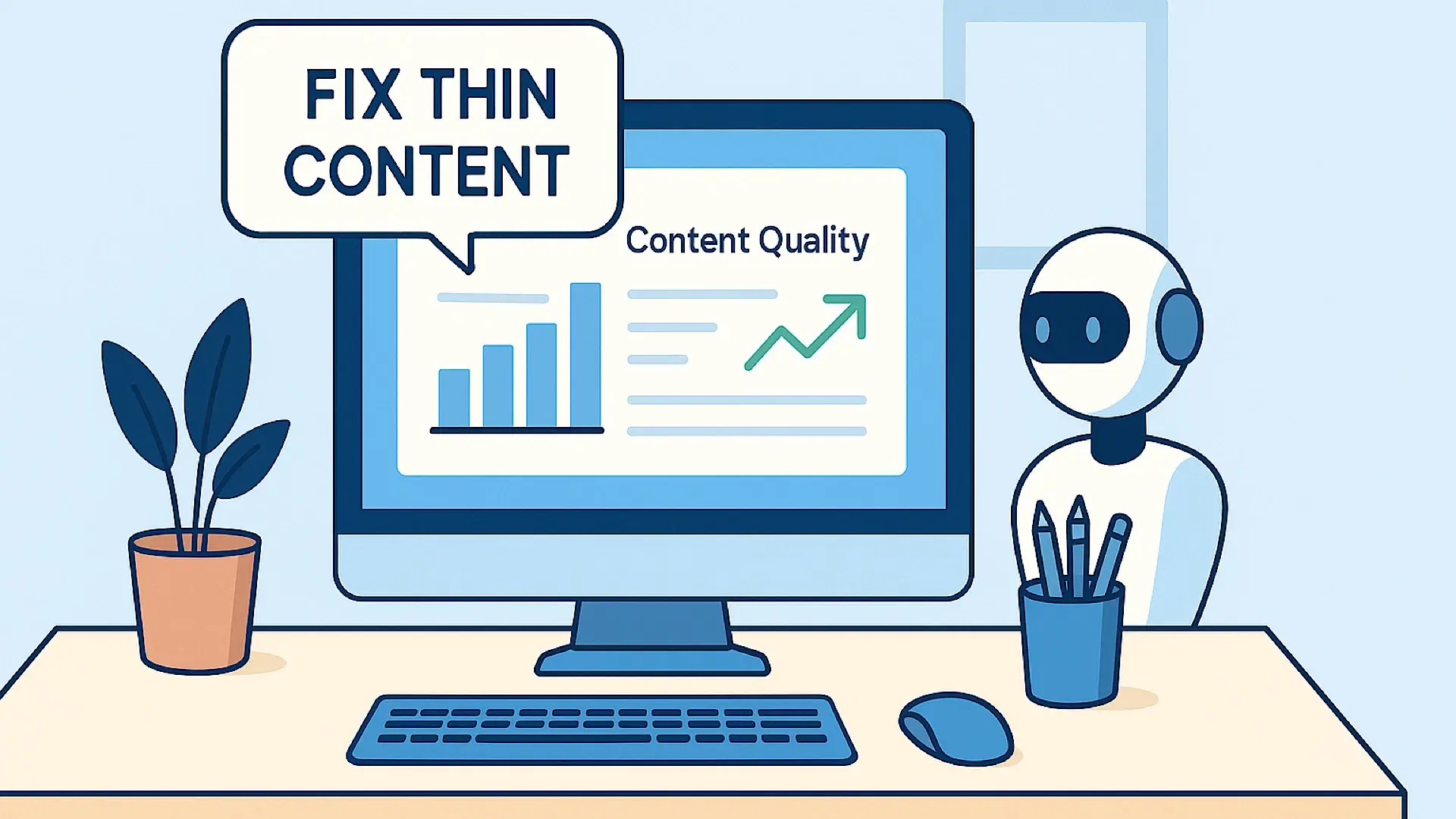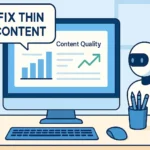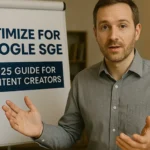How to Fix Thin Content Penalty in 2025 (AI-Powered Solutions)

Introduction: Why Thin Content Still Matters in 2025
Fix Thin Content Penalty issues in 2025 before they sabotage your SEO efforts. Despite constant algorithm changes, some fundamentals never fade—especially for those who start a blog and make money but overlook content depth and user value.
Thin content isn’t just about word count; it’s about a lack of substance, originality, or relevance. Even a 2,000-word article can be deemed “thin” if it fails to offer meaningful insights, answer user questions, or provide unique value. With the rapid rise of AI content generation tools, many creators unknowingly publish grammatically correct—but shallow—content that triggers penalties instead of engagement.
Google’s Helpful Content Update (HCU), combined with the May 2024 Core Update that cracked down on AI-generated content farms, has raised the quality bar higher than ever. To stay competitive in 2025, your content must clearly demonstrate Experience, Expertise, Authoritativeness, and Trustworthiness (E-E-A-T)—not just keywords and formatting tricks.
How to Determine If You Have Thin Content Issues
Before implementing solutions, you need to identify if your site has thin content problems. Here’s how to conduct a thorough assessment:
Using SEO Tools for Diagnosis
Modern SEO platforms offer specialized reports to identify potential thin content issues:
- Google Search Console: Check the “Coverage” report for indexed pages with minimal traffic or engagement metrics.
- Ahrefs: Use the Content Audit tool to find underperforming pages based on organic traffic and backlinks.
- SEMrush: The Content Audit feature can flag thin content based on performance metrics and content quality scores.
- Screaming Frog: Identify pages with low word counts, duplicate content, or excessive boilerplate text.
Manual Review Indicators
Beyond using tools, conduct a hands-on review looking for these common thin content red flags:
- Brevity Without Value: Pages with fewer than 300 words that don’t fully address the topic.
- Duplicate or Near-Duplicate Content: Similar content across multiple pages with minimal variation.
- Excessive Affiliate Links: Pages overloaded with promotional links but little substantive information are common in affiliate blogs. If you’re just starting out, check out these affiliate programs for beginners that actually encourage quality-driven content.
- Automatically Generated Content: Mass-produced content created without human oversight or editing.
- Poor Engagement Metrics: High bounce rates and low time-on-page indicate content isn’t meeting user needs and may be flagged by Google, signaling it’s time to fix thin content penalty triggers.
- Keyword Stuffing: Content that repeats keywords unnaturally to manipulate rankings.
- Lack of Multimedia Elements: Pages with text only, missing images, videos, or interactive elements.
AI-Powered Solutions to Improve Thin Content (2025 Edition)

The irony isn’t lost on us – while AI can contribute to thin content problems, it can also help you fix thin content penalty issues when used strategically. Here’s how to leverage AI tools effectively:
3.1 Making Content Deeper and More Informative (AI + Human Touch)
The most effective approach combines AI assistance with human expertise:
The most effective approach combines AI assistance with human expertise to fix thin content penalty risks and produce content that satisfies both algorithms and users.
Step 1: Use AI for Research and Structure
- Tools like Claude 3.7 Sonnet, GPT-4o, and Gemini Advanced excel at identifying content gaps in existing articles.
- Input your current content and ask: “What crucial information is missing from this article about [topic]?”
- Have the AI create an expanded content outline with subtopics and key points.
Step 2: Human Expertise Enhancement
- Add personal experiences, case studies, and industry insights that AI cannot generate—similar to what’s done in detailed comparisons like ConvertKit vs Mailchimp where context truly matters.
- Incorporate original research, quotes from experts, or unique perspectives.
- Refine AI suggestions based on your knowledge of your audience’s specific needs.
Real-World Example:
| Before | After AI-Assisted Transformation |
|---|---|
| 300-word article on “Best SEO Practices” with generic tips | 2,500-word comprehensive guide with industry-specific implementation strategies, expert opinions, real-world case studies, and performance data |
Tools to Consider:
- Content Research: Claude 3.7 Sonnet, ChatGPT-4o, Gemini Advanced
- Structure Optimization: SurferSEO, Clearscope, MarketMuse
- Writing Assistance: Jasper AI, Frase, WordHero
3.2 Optimizing Content for Search Intent (AI-Driven Intent Analysis)
Modern SEO requires satisfying the complex, multi-faceted nature of search intent—especially if you want to fix thin content penalty issues that arise from misaligned or incomplete content:
Step 1: Intent Analysis
- Use tools like Frase.io and Clearscope to analyze the top-performing content for your target keywords.
- Identify patterns in content types, formats, and information provided by high-ranking pages.
- Determine if the dominant intent is informational, commercial, navigational, or transactional.
Step 2: Comprehensive Coverage
- Create content that addresses all aspects of the search intent spectrum.
- For product-related content, include comparison tables, pricing information, and user experiences.
- For informational content, provide definitions, step-by-step guides, examples, and FAQs.
Complex Intent Example: For the keyword “best protein powder,” comprehensive content would include:
- Expert nutritional information (informational)
- Product comparisons with pros/cons (commercial)
- Personal experiences and results (testimonial)
- Pricing and availability data (transactional)
3.3 Adding Multimedia Content (AI-Generated Visual Assets)
Rich media significantly improves engagement metrics and provides additional value—both critical when aiming to fix thin content penalty signals in your content:
Step 1: AI-Generated Visual Elements
- Use Midjourney, DALL-E 3, or Stable Diffusion XL to create custom illustrations that explain complex concepts.
- Generate infographics that summarize key points or statistics.
- Create custom charts and diagrams that visualize data relationships.
Step 2: Interactive Elements
- Embed calculators, quizzes, or tools relevant to your topic.
- Add comparison sliders for before/after scenarios.
- Include interactive timelines for historical or process-based content.
Example Implementation: A fitness blog transformed a thin “How to Calculate Macros” article by adding:
- AI-generated custom illustrations of food portions
- An interactive macro calculator
- Infographics comparing different diet approaches
- Short-form video demonstrations
Tools to Consider:
- Image Generation: Midjourney, DALL-E 3, Stable Diffusion XL
- Video Creation: Synthesia, Runway, D-ID
- Interactive Elements: Outgrow, Involve.me, Calculoid
3.4 Automated Content Refreshing (AI-Powered Updates)
Keep content fresh and relevant with AI-assisted updating processes:
Step 1: Set Up Automated Monitoring
- Use tools like ContentKing or Semrush’s Post Tracking to monitor performance metrics.
- Establish thresholds for engagement drops that trigger content reviews.
- Track competing content to identify new angles or information that could help you fix thin content penalty issues before they lead to ranking drops.
Step 2: AI-Assisted Updates
- Use Claude 3.7 Sonnet or GPT-4o to analyze your existing content against recent search results.
- Request specific updates based on new research, statistics, or industry developments.
- Add new FAQs based on People Also Ask boxes for your target keywords.
Success Story: Health information site Healthline maintains top rankings by using AI tools to flag medical content needing updates. Their automated system identifies:
- New research publications
- Changed medical guidelines
- Emerging treatment options
- Fresh statistical data
The content team then uses AI assistants to draft updates that are reviewed by medical professionals before publishing.
How to Verify Your Optimized Content Is No Longer “Thin”
After implementing improvements, you need objective ways to measure success:
Google Quality Rater Guidelines Assessment
Review your content against Google’s official evaluation criteria:
Ensuring your content aligns with E-E-A-T is one of the most effective ways to fix thin content penalty issues and restore trust and rankings.
- Experience (E): Does the content demonstrate first-hand experience with the topic?
- Expertise (E): Does it show deep knowledge and understanding of the subject?
- Authoritativeness (A): Is it written or reviewed by recognized experts?
- Trustworthiness (T): Is information accurate, transparent, and properly sourced?
When implemented consistently, these four principles form a solid foundation to fix thin content penalty issues site-wide.
Core Web Vitals and User Engagement
Track these technical and behavioral metrics:
- Improved Time on Page: Has average session duration increased? Similar to how optimized emails improve open and engagement rates, your content should encourage visitors to stay and explore. Learn how to increase email open rates with smart content structuring.
- Reduced Bounce Rate: Are more visitors exploring additional content?
- Page Speed: Has adding multimedia affected loading times? Optimizing speed and mobile UX can directly help fix thin content penalty problems caused by poor engagement and usability.
- Mobile Experience: Is the enhanced content still mobile-friendly?
- Scroll Depth: Are users consuming more of your content?
Backlink Analysis
Monitor how other sites respond to your improved content to ensure your efforts to fix thin content penalty problems are earning recognition, backlinks, and engagement:
- New Backlinks: Are quality sites now linking to your content?
- Social Shares: Has social media engagement increased?
- Citation Growth: Are other authors referencing your work?
Tool Recommendation: Ahrefs’ Content Explorer allows you to track mentions of your content across the web, even when they don’t include a backlink.
Future-Proofing: How to Avoid Thin Content Penalties Going Forward
Building a Sustainable Content Strategy
Rather than reacting to penalties, establish proactive practices that help you fix thin content penalty issues early and avoid them long-term:
- Content Calendar: Schedule regular audits and refreshes for all content.
- Topic Clustering: Group related content to build comprehensive coverage.
- Expertise Development: Cultivate genuine knowledge in your content niche.
- User Feedback Loop: Incorporate reader questions and comments into content updates.
Regular Content Audits
Implement a systematic review process:
- Quarterly Performance Reviews: Identify underperforming content for improvement and fix thin content penalty triggers before they damage your traffic.
- Annual Deep Dives: Completely refresh cornerstone content with new research and examples.
- Competitive Benchmarking: Compare your content depth against top-ranking competitors.
The Hybrid Approach (AI + Human Expertise + Expert Input)
The most sustainable model combines multiple sources of value:
- AI Tools: For research, structure, and identifying content gaps.
- Human Writers/Editors: For creativity, original insights, and narrative flow.
- Subject Matter Experts: For technical accuracy, cutting-edge information, and authority.
Real-World Implementation: Financial advice site NerdWallet uses this hybrid approach, with AI systems identifying trending topics and content gaps, writers crafting engaging content, and certified financial advisors reviewing for accuracy and adding expert insights.
Conclusion
Thin content penalties remain a significant threat in 2025, but they also represent an opportunity to substantially improve your site’s value proposition—especially when you strategically fix thin content penalty issues using AI and human expertise. The most effective approach isn’t to view AI as either a problem or solution, but as a powerful tool within a comprehensive content strategy.
Start by conducting a thorough content audit to identify underperforming pages—this is your first step to effectively fix thin content penalty problems and regain lost SEO value. Use AI tools strategically to enhance depth, research, and multimedia elements – but always maintain human oversight and expertise. Finally, implement regular monitoring and refreshing processes to ensure your content continues to meet evolving user needs and search engine expectations.
Remember: Quality content isn’t just about avoiding penalties – it’s about building genuine authority and delivering real value to your audience, including how to monetize your email list with useful and trust-based content. When used correctly, AI can help you achieve both goals more efficiently than ever before.
FAQ Section
Q1: Can AI-generated content still rank well in 2025?
A: Yes, but only when it’s properly supervised and enhanced by human expertise. Google’s algorithms don’t penalize AI content specifically – they penalize low-quality, unhelpful content regardless of how it was created. The key is using AI as a tool to enhance research, structure, and ideation while adding genuine expertise, original insights, and verifiable information that serves user intent.
Q2: What’s the minimum word count to avoid thin content penalties?
A: There is no universal minimum word count. Content length should be determined by the complexity of the topic and what’s needed to thoroughly address user intent. Some topics might require 3,000+ words for comprehensive coverage, while others might be fully addressed in 800 words. Focus on completeness and value rather than arbitrary word counts.
Q3: How often should I update existing content to avoid thin content penalties?
A: For most content, quarterly reviews are sufficient, with updates made when new information becomes available or when performance metrics decline. Time-sensitive topics or rapidly evolving fields (like technology or health) may require monthly reviews. Cornerstone content should receive a comprehensive refresh at least annually, regardless of performance.
Q4: Is it better to improve thin content or delete it?
A: It depends on the content’s potential value and strategic importance. Use these guidelines:
- Improve: Content with steady traffic, strategic keywords, or potential for enhancement
- Consolidate: Similar thin pages that could be combined into comprehensive guides
- Delete: Content on outdated topics, pages with no traffic/backlinks, or duplicate content
Q5: How do I balance comprehensive content with readability?
A: Use strategic formatting to make comprehensive content accessible:
- Break content into clear sections with descriptive headings
- Use bullet points and numbered lists for key points
- Include a table of contents for easy navigation
- Add visual elements to break up text and illustrate concepts
- Consider creating “expanded” sections that users can click to reveal detailed information








